A campaign by U.S. and Brazilian activists challenging TIAA and other financial firms’ complicity in land grabs and deforestation in Brazil is scoring major victories.
Altamiran Ribeiro lives in the south of Piauí, in the savanna region of Brazil. Despite being considered one of the most biodiverse ecosystems on the planet, the Brazilian Savanna biome, called the Cerrado, started to appear in the media and in public debate as an “unproductive” and “empty” area over the last decade. Recently, the region is most known internationally as Brazil’s soy frontier, and this portrait has facilitated the opening of these lands to the expansion of agribusiness.
Ribeiro has been an active organizer with a Catholic Church movement associated with liberation theology since his childhood in the 1980s and describes growing up in that area as inevitably facing hunger. Liberation theology is a Christian theological approach emphasizing the liberation of the oppressed, developed within the Catholic Church in Latin America in the 1960s, as a moral reaction to the poverty and social injustice in the region. The movement still inspires social action throughout rural Brazil, especially through the work of the church’s pastoral commissions. The Catholic Church became Ribeiro’s escape from harsh realities, and his passion for people led him to join the Children’s Pastoral Commission and later the Pastoral Land Commission, or CPT, where he serves as the coordinator for the state of Piauí.
Inspired by the liberation theology movement, CPT was established in 1975 during the Pastoral Meeting of the Amazon convened by the National Conference of Bishops of Brazil. As a key player in grassroots organizing in rural Brazil, CPT has a long track record of supporting grassroots organizing for social justice and land rights. It also publishes an annual report on conflicts over land in Brazil which indicated a sharp increase in lethal violence against rural communities in 2021.
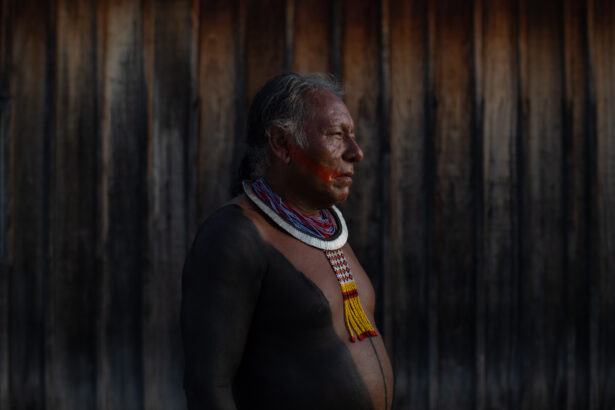
Ribeiro remembers when the idea of the Cerrado as a vast empty space started to be promoted by government officials and agribusiness corporations, despite the fact that the region is home of many Indigenous and peasant communities. He started to document cases of repression and displacement of rural families for CPT reports. It was at that moment when he received a call from a researcher from Rede Social de Justiça e Direitos Humanos — a Brazilian NGO that provides legal defense, grassroots education, research, alliance-building and advocacy tools to advance land rights in rural communities. The researcher wanted Ribeiro’s help in a survey Rede Social was doing in the region.
Brazilian researcher and Rede Social co-founder Maria Luisa Mendonça describes seeing a trend taking off around 2008. After the collapse of the housing market in the United States, financial corporations started to channel significant amounts of funds to speculate in farmland markets and to promote the expansion of mono-cropping plantations, especially of soy and sugar in Brazil.
The U.S. connection
In 2015, the New York Times drew much-needed attention to the issue when it published a story exposing how a major pension fund in the United States, the Teachers Insurance and Annuity Association of America, or TIAA, was involved in some very questionable land dealings in Brazil. Mendonça began investigating this issue in 2016, when it was revealed that Cosan — Brazil’s then-largest sugar producer, which had also just merged with Royal Dutch Shell to form the world’s largest biofuel operation — had created a new subsidiary company called Radar. Radar was a new type of real estate company, primarily offering land in rural areas to international buyers, including TIAA.
As the largest manager of farmland in the world — with over 2 million acres on four continents worth over $8 billion — TIAA manages retirement savings for almost 5 million U.S. college faculty, staff and many nonprofit employees.
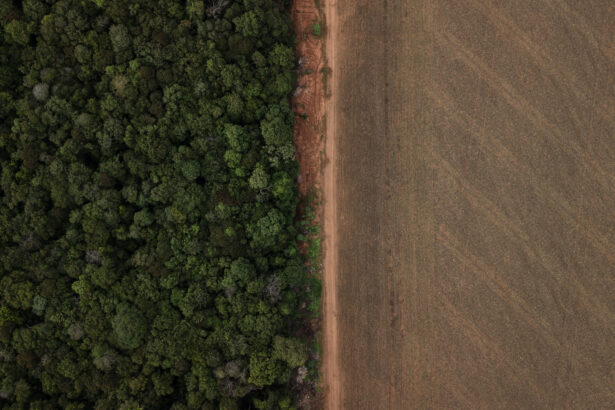
Mendonça explained that a large extension of land in the Cerrado is public (Brazil has 766 million acres of public forests and reservations). She noted that both Harvard and TIAA bought land from a famous land grabber from the region.
ActionAid USA senior policy analyst Doug Hertzler described becoming aware of TIAA’s involvement in buying rural lands in contested areas around 2012. When ActionAid USA realized what was happening, they decided to approach TIAA, which manages their employees’ pension funds. (A number of other NGOs, as well as health care workers unions, have their pension funds managed by TIAA.)
“TIAA was taking retirement fund investment in the direction that goes completely against what we are working for and being deceptive about it too,” explained Tristan Quinn-Thibodeau, the national campaigner at ActionAid USA. The fact that ActionAid is an anti-hunger, anti-poverty organization, made things worse. While TIAA claims that its investments in land and agriculture will contribute to the U.N.’s goals of zero hunger through food security, Quinn-Thibodeau says that “nothing could be further from the truth.”
Eventually, ActionAid USA wrote to TIAA and formally objected to the way money was being invested. ActionAid activists knew that changing their retirement fund manager would not solve the problem, so a group of employees took it upon themselves to speak to the organization. Since TIAA claims to be a socially responsible investor, they wanted to see if they could have leverage as clients. “Being part of other networks that had already been doing work related to food security and access to land helped in getting the word out, and slowly a coalition started to take shape,” Hertzler said.
The Stop Land Grabs coalition, which leads the Stop Land Grabs campaign, has been active since 2016. The coalition brings together farmer, environmental, faith, human rights and civil society organizations that have worked to expose financial firms’ complicity in land grabs and deforestation in Brazil, as well as the corporate consolidation of agriculture in the United States. Current members include ActionAid, Grain, the National Family Farmers Coalition, Uprooted and Rising, Grassroots International, the Presbyterian Hunger Program, Friends of the Earth U.S. and Rede Social.
The campaign has three main strategies: Grassroots organizing among affected populations, organizing among TIAA clients, and advocacy for policy change. The first is its connection with communities on the front lines, making sure the campaign is grounded in a bottom up perspective. The second part is trying to engage TIAA pension holders, the academic community and other workers, who might know that TIAA manages their pension but don’t know that farmland is a target of financial speculation. The third focus of the campaign is trying to push governments to change land governance rules and ensure that the land rights of family farmers and rural communities are protected, and not sacrificed at the altar of corporate profits.
Laura Graham is an anthropologist, professor at the University of Iowa and organizer with the coalition. She has done research with the Xavante Indigenous Peoples in the Mato Grosso state in Brazil, also in the Cerrado, for almost 40 years. She describes witnessing the devastating effects of agriculture monocrop expansion in the interior of Brazil and its impact on local communities. When the New York Times article pointing to the dealings of TIAA on financialization of farm land in Brazil came out in 2015, she got together with another professor who works on land tenure and they approached the American Anthropological Association with the idea of beginning a dialogue with the pension fund. TIAA initially sent people from their PR department to talk to them.
“They showed us the maps that they use to claim they were not advancing in contested areas,” Graham explained. “But the maps that they use don’t show areas that are currently pending [Indigenous] demarcations for example. And there’s 155 cases that are currently pending.”
They pointed out to them that maps were inadequate, and they did not think the data presented by TIAA was based on information from people who have expertise in the area. “[We told them that] they needed to do better due diligence, and that this was not a good use of our money as TIAA clients,” Graham said. The group also asked to meet with people higher up in TIAA; they learned that other organizations were attempting to do the same, and were not able to speak with people in decision-making positions at TIAA. “At that point I began to mobilize on my campus,” Graham explained.
The group at the University of Iowa started mobilizing in 2019. They first presented a petition to the university’s charter sustainability commission, calling for greater accountability and transparency with regard to how their pension funds were invested in farm land acquisitions. The resolution passed with overwhelming support in May 2021. The next step was to establish dialogues with the university’s executive body and full staff. Last July, the University of Iowa Senate also passed the resolution. Now these bodies will be working with the retirement committees, communicating their demands directly to TIAA. “From my perspective as an individual client, I don’t want my retirement funds invested in anything that has to do with land grabbing anywhere in the world,” Graham concluded. “The University of Iowa faculty and staff bodies want TIAA to put in measures that show that it is upholding its sustainability and human rights commitments.”
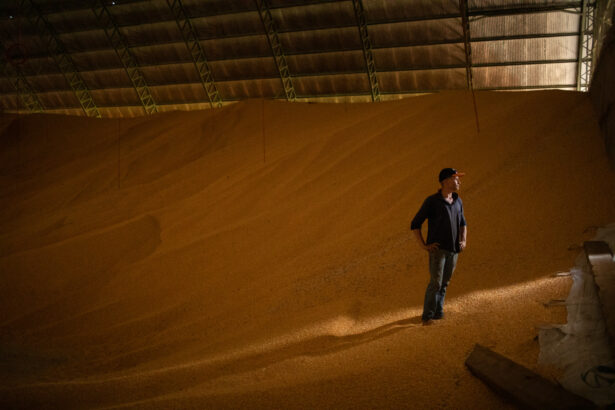
Hannah Weinronk and Kathleen Melendez are both organizers with Uprooted and Rising, a movement organization involved in the fight for food sovereignty that challenges higher education’s role in the corporate-industrial food system — supporting both student and community groups to run campaigns. Weinronk first heard of the Stop Land Grabs campaign when she attended a meeting organized by a group of faculty with researchers from Rede Social at Harvard University. When she learned that the group at Harvard was looking to bring this issue to the attention of members in their community, they started networking and eventually Uprooted and Rising joined the campaign. Their short-term goal is to expand student-led initiatives to other universities.
Melendez, who is the Southern coordinator with Uprooted and Rising, has described how investment dynamics that are pushing local populations out of rural land in Brazil are also affecting parts of the Mississippi Delta region, where her work is focused. “We have a pretty strong grounding in food sovereignty and justice,” she explained, “but the particulars of how farmland speculation works, are not necessarily all common knowledge. We’re also trying to break that down for our network in the United States.”
The National Family Farm Coalition is an alliance of 30 farmer, rancher and fisher-led organizations across the United States, and is another member of the Stop Land Grabs coalition. Jordan Treakle is the national programs and policy coordinator and he leads the organization’s advocacy work, amplifying grassroots voices at the federal level. The National Family Farm Coalition has been working on the issue of land grabbing with some of the campaign partners since 2008. “Around that time we saw these major corporate actors and money managers choosing land as a stable asset to hedge against market fluctuation and essentially seeing it as a long-term safe place to park money or capital,” Treakle said.
Treakle stressed the importance of examining the ways in which that dynamic plays out not only in Brazil, but in North America as well. He pointed out that more than half of the farmland in the United States is expected to change hands in the next 10-15 years, and the current trends point to an increase in corporate-owned land. Pension funds — especially TIAA — are major players, wielding incredible economic power, in this story.
Everyone interviewed for this story mentioned that they tried to have an honest conversation about these issues with TIAA management for years with little to show for it. “We’ve had sit downs with them and laid out our concerns,” Graham said. “We have brought activists from Brazil to speak for themselves, but TIAA has not taken accountability for the social and economic impacts of their actions.”
On the other hand, members of the coalition seem to agree that the campaign is gaining momentum, and there have been some important victories along the way. “We’ve gotten a number of different universities interested,” Treakle explained, “and I think that there’s an important message to TIAA leadership, that the folks that they serve are not happy.”
In Congress, the coalition has been able to start to unpack the complex context of land governance, including the legacy of slavery and colonialism, and land ownership. The fact that it is starting to be talked about in Washington D.C. is considered a win. Treakle describes the Justice for Black Farmers Act, which calls on the government to closely track corporate ownership of farmland in the United States and sets up mechanisms to protect farmers’ land rights, as one piece of the puzzle. For Treakle, it’s important that land is incorporated into that major policy discussion around agriculture governance as the next farm bill cycle starts to ramp up in the Congress. “That is where we are positioning and getting our members on the same page,” he added, “to push our congressional allies to start addressing the issue of farmers’ land rights and corporate land ownership in the farm bill in new ways.”
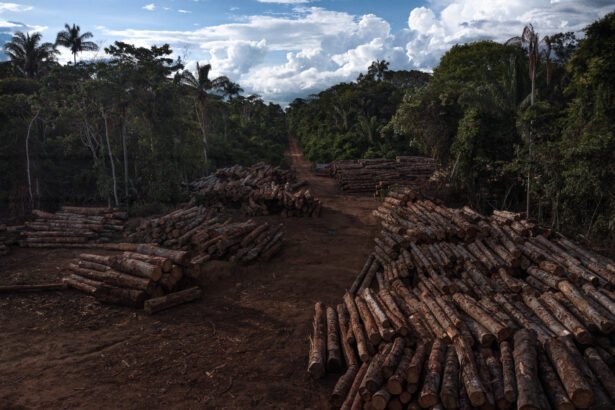
Getting the information they have been gathering to more students, faculty and staff, on more college campuses, is another priority for the coalition. Quinn-Thibodeau emphasized the need to make connections between industrial farming and climate change. “Many people were affected by the release of the IPCC report this summer,” he said, “but not much is talked about when it comes to industrial agriculture and deforestation being major contributors to the climate crisis.” For him, what is becoming clearer is that financial institutions are acquiring farmland to be used by corporations that will claim to be sequestering carbon, helping these companies become “carbon neutral.” According to Quinn-Thibodeau, TIAA, in particular, is very interested in getting carbon credits and exploring biofuel production in order to claim it is sustainable. However, evidence suggests that things such as biofuels and biomass energy are not as “green” as they are being portrayed.
When asked about where they take inspiration for putting this campaign together, both Via Campesina and the fossil fuel divestment campaign came up — one as a model for grassroots organizing, the other for mobilizing investors and the public at large. Via Campesina has been a reference for international grassroots organizing, uniting peasants, small and medium-sized farmers since it was created in 1993, in response to increasingly globalized agricultural policies and the expansion of the agribusinesses (representing 200 million farmers worldwide). The fossil fuel divestment campaign has had major wins in the last year — with Harvard being one of eight Ivy League universities committing to divest and Exxon Mobil’s board seeing the addition of two anti-fossil fuel activists.
Hertzler pointed that one of the challenges has been to adapt strategies used for fossil fuels to agriculture. “We can’t just say we don’t want industrial agriculture to fund agroecology, because agroecology requires a different kind of economic model,” he explained. “And we don’t really have the infrastructure for agroecological farming yet, which would take hundreds of millions of dollars in investment.”
Back in Brazil
TIAA currently controls over 800,000 acres in farmlands in Brazil that the coalition has shown are contributing to the destruction of forests, soil and watersheds. Ribeiro says the Cerrado’s communities and biodiversity are at risk because of agribusiness expansion. Earlier this year, Smoke Signal, an independent monitor of the socio-environmental crisis in Brazil, published a special feature pointing out that deforestation in illegally grabbed areas in the Cerrado and the Amazon increased by around 50 percent since President Jair Bolsonaro took office in 2018. Other recent studies showed a 55 percent increase of illegal land registries overlapping with Indigenous territories between 2016 and 2020.
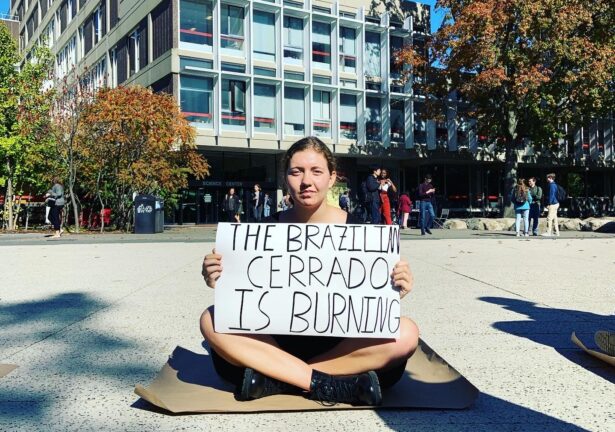
But the organizing that was fueled by Rede Social’s initial research — along with the continued support of Rede Social, CPT and the Stop Land Grabs coalition in the United States — led to some significant victories. The Brazilian justice system deemed Harvard’s land business in the area illegal after a legal inquiry. The grassroots organizing on the ground led by CPT resulted in the formation of a collective uniting Indigenous and peasant communities in the state of Piauí to fight for their rights.
Ribeiro says that a new wave of communal lands regulations started after a petition presented to the World Bank’s Inspection Panel on behalf of affected communities. As part of their investigations, CPT, Rede Social and ActionAid eventually found out that the World Bank financed a project with the Land Institute of the State of Piauí that involved land titling in that area. When they went to look at the project, they realized the institute was granting titles to corporations, but not to the communities that had been in the area long before.
Mendonça explained that based on Brazilian agrarian regulations, areas granted for communal use — such as Indigenous, Quilombolas and those settled by the Landless Workers Movement — remain public land. The communities can use the land, but not sell it. This is considered a very important element of their struggle, since private land tends to be more vulnerable to the kind of pressure exerted by corporations.
After a series of meetings between the organizations and the World Bank took place, both in Brazil and in Washington D.C., the bank sent a mission to survey the area and talk to traditional communities. As a result, the bank said that the state land institute had to prioritize collective land titling over the land illegally acquired by corporations. Through the collective’s work, they were able to question a World Bank project in the region that was promoting privatization of community lands. Several communities are now in the process of demanding collective land rights. Another important win was the approval of new legislation in the state of Piauí that includes provisions to support collective land regulations for Indigenous, Quilombola and other traditional communities in the state.
“The kind of powerful potential we have when we organize with communities on the frontlines fighting land grabs — being in conversation with the people in other parts of the world who are also ready to take action and build power together — is one of the things that inspires me the most,” Melendez explained.
Ribeiro says that he knows this is an ongoing struggle. Despite the constant attempts by agribusiness to demobilize the movement by promoting fear, violence and repression, he described being grateful for all of the work that folks in Rede Social and other organizations in the coalition are doing to stop land grabs. “It’s important that people in the United States know that their money is killing other people,” he said.
This story was produced in collaboration with Smoke Signal Monitor to raise awareness of topics relevant to the socio-environmental crisis in Brazil and it’s international connections.
October 1, 2021
fonte:https://wagingnonviolence.org/2021/10/coalition-resisting-tiaa-harvard-stop-land-grabs-deforestation-brazil/











